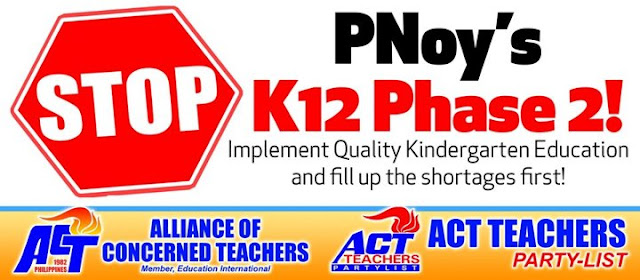K to 12, 13 Years of Basic Education
There are two major opinions regarding basic education. It prepares students for a career or employment. It is also viewed as a stepping stone to higher education or college. Whatever the objectives are, basic education is universally composed of stages. This is how human learning works. We learn to walk before we learn to run. Knowledge and skills are both cumulative. With this in mind, whether basic education is aimed at a vocation or college education becomes irrelevant. The "basic" in basic education means that the early stages are meant to serve both tracks. For this reason, when basic education is failing it is important to pinpoint where the problem is first evident. Not doing so denies completely the fact that education is very much akin to climbing a ladder.
The years of basic education are divided into stages. There is elementary or primary school. In places like the United States, the elementary years are followed by middle school and then the last stage is called high school. Nowadays, there are several years in addition to kindergarten that precede first grade. With the perspective of education occurring in stages, basic education can be examined in terms of how a student progresses. With an eye for levels, the objectives for each stage can be defined. Each level has a purpose.
Due to children being born and raised in different socio-economic conditions, there are gaps right at the beginning of formal basic education. Thus, one way to evaluate basic education is to examine whether schooling helps narrow this gap. Equity in education is a value that society recognizes, at least, in words. The current president of the Philippines in fact cites equity as one of the driving forces behind adding kindergarten and two years at the end of high school to the basic educational system in the Philippines. Therefore, it is only appropriate to examine if the new curriculum does achieve an enhancement in equity in education. How equity can be enhanced is particularly elusive if at the same time, advancement in the name of excellence is equally pursued. This may seem ironic but the "tug-of-war" between equity and excellence arises from a question of priorities and opportunity costs.
Looking at how the educational system in the United States has evolved, one notices, for example, a shift in the objectives of each stage in basic education. The middle school was initially established to help students who were not yet fully prepared for high school. In the Philippines, some private schools already had an additional year in elementary school. Thus, at this point, one could already ask the question of whether grade 7 is addressing gaps, remediating or bridging between elementary and high school, or, is it becoming the first year of high school? One can even go farther back and ask; Is preschool a preparation for kindergarten, or is kindergarten being transferred to preschool?
These questions may seem trivial at this point and people may be quick to answer that advancement is a sign of progress. However, such thinking fails to take into account prioritization and opportunity costs. This failure unfortunately becomes automatic when one focuses merely on the curriculum and neglects the realities of implementation. To illustrate this dilemma, the Advanced Placement program in the United States K-12 system can be used as an example. Challenge Success has recently assembled a white paper,"The Advanced Placement Program: Living Up To Its Promise?" The following is the overview of this paper:
Overview
The College Board’s Advanced Placement (AP) program is considered by many to be the gold standard for a topnotch high school education, and it is often heralded as a powerful tool for achieving educational equity, but is it? This paper, based on extensive review of the literature, will consider:
- Does taking AP classes make students more likely to succeed in college?
- Does taking AP classes boost a student’s chances of college admission?
- Does taking AP classes make college more affordable?
- Does the AP program help to narrow achievement gaps?
- Does the AP program enrich students’ high school experiences?
- Are schools with an AP program better than those without?
We conclude by offering a series of recommendations for educators and students aimed at making the Advanced Placement program a net positive.The answers to the above questions based on their review of literature are hardly affirmative. Challenge Success' overall impression of the AP program can be obtained from the following paragraph:
In the best of circumstances, the AP program can enrich some students’ high school studies and offer opportunities to take challenging college-level courses, with motivated classmates and highly skilled teachers. For certain students who would not otherwise have access to these kinds of college-level courses, the AP program may be particularly beneficial. However, definitive claims about the AP program and its impact on students and schools are difficult to substantiate. Some of the research about the AP program merely establishes correlation and not causation.Seeing the difference between correlation and causation is necessary especially when one places emphasis on excellence and not equity. When an advanced program caters only to good students right at the beginning, it is only proper to question whether good students would actually succeed with or without an advanced program. The other equally important phrase in the above paragraph is "highly skilled teachers". We must realize that advanced programs come with a price, a cost of opportunity. This is where equity clashes with excellence as well. Advanced programs will draw the skilled teachers from other programs. If advanced programs cater only to a selected few, then the skilled teachers are then drawn away from the larger population where help from skilled teachers is much more needed. When resources are limited, one must prioritize. When needs are far greater than the resources, one must make a choice. And the most important question is about equity. "First things first."

Comments
Post a Comment